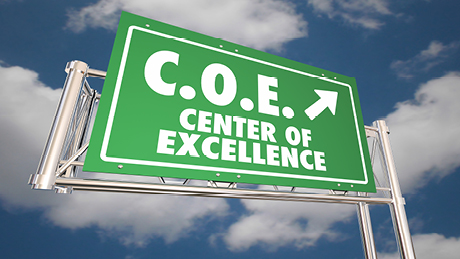Centers of Excellence (COEs) are your path to beating your competition – Part 1 (the foundation)

Access to very specialized, innovative data expertise is crucial these days. Enterprises of all sizes face increasing pressures from very nimble and efficient startups, changing market trends and global health challenges. Successful enterprises will need to do things better and faster than they ever did and adapt and innovate better than their competitors to succeed.
As a result, COEs are in more demand than ever, and the Analytics COE is leading the way. COEs are no longer a luxury afforded by very large F100 and F500 enterprises and are finding their way to medium and small companies, albeit, at a smaller scale.
Strategic enterprises are thus considering COEs and an increased focus on the management of their data assets as key competitive differentiators, so many organizations are taking COEs more seriously than ever.
In this first of three installments I will lay the foundation and definition for the Analytics COE, outline its key benefits, prerequisites for success, key drivers, and what COEs are not and should not provide.
References throughout the three installments span the last 3-5 years. The challenges and benefits of COEs have been consistently increasing over time.
- Gartner learned in one study that 75% of organizations will fail to achieve the full potential of the internet of things (IoT) due to lack of access to data scientists and another 80% of companies that expected to employ AI by 2019 failed for similar reasons.
- The pandemic has raised awareness of the increased need and benefits of having an Analytics COE (https://www.hfma.org/finance-and-business-strategy/analytics/data-analytics-center-of-excellence)
Overview
The COE stands for Center of Excellence or Expertise. It is often referred to as the Center of Competency or COC. The Analytics COE is often called the Business Intelligence Center of Competency or BICC, or the Analytics Center of Excellence or ACE. Other notations may also include COEI (Center of Expertise and Innovation).
For the purposes of this discussion, I would like to use the name Center of Expertise and Innovation or COEI, since it best describes what it needs to be and what it will do. In my next entry in the series I will highlight the capabilities and advantages of a Data Management COEI.
There are many types of COEs. Here are just a few:
- Analytics (business analytics)
- Data Integration
- Data Management and Data Governance
- Program/Project Management
- Internal Consulting for Application Development
- Testing and Quality Assurance
- Continuous Improvement/Operational Excellence and Supply Chain
Focusing on the first 2-3 COEs in this list will provide your enterprise with tremendous, tangible value, value that increases drastically when the COEs leverage an integrated, mature set of Data Integration, Governance and Management tools that work seamlessly to support your enterprise analytics solutions.
The COEI is a centralized data & analytics organization meant to streamline all enterprise analytical efforts while standardizing analytics demands/requests and the way analytics are presented and consumed. It is staffed by a group of very senior, dedicated, intelligent and experienced business and data experts that are aligned with and serving multiple Lines of Business (LOBs) with their Analytics requirements, including:
- Machine Learning and Artificial Intelligence
- Data Mining and Complex Predictive and Trending Modeling
- Performance and Management reporting
- CRM analytics
- Marketing Digital Campaign analytics
This COEI aims to help multiple LOBs focus on their businesses’ reporting and analytics needs by producing the required analytics as well as enabling as many self-service facilities for these LOBs as possible – so that LOB staff can stop focusing on data wrangling (data massaging and cleaning) and more on producing analytics that drive business value.
According to Gartner, COEs exist to “concentrate existing expertise and resources in a discipline or capability to attain and sustain world-class performance and value.” These virtual or physical centers combine learning and oversight in a specific area, driving the organization to shift across multiple disciplines together.
So why are COEIs needed?
The COEI will deliver multi-faceted, tangible, and intangible value to the enterprise, and is made up of a team of dedicated individuals outside of the LOBs or functional areas that it supports within the enterprise. The COEI usually leads the way in analytics innovation and in exploring and developing, adopting, and standardizing tools, techniques, and best practices.
This group operates across the enterprise and focuses on:
- Performing analytical and data science critical functions and providing analytics thought leadership, innovation, research, best practices, and direction
- Delivering proven, repeatable analytical results in a much timelier fashion as well as the required communications and training
- Reducing the need for LOBs to focus 20-50% of their analytical staff on data wrangling and reporting and by identifying and reducing duplication of effort across initiatives within the LOB or the enterprise
- Fine tuning analytics organizations by centralizing and training and cross-training key resources (retaining key business, data, and tribal knowledge by retaining and motivating resources with high-demand skills and unique business knowledge)
- Improving ROI through the identification and development of reusable assets (reports, dashboards, heatmaps and scorecards) and by rationalizing and standardizing the tools that are best suited for specific analytics
- Helping identify and resolve enterprise Data Quality and Integrity, Governance, Lineage and Stewardship disputes
I am always asked what does not belong in an Analytics COEI and what should be included among the functions of the Analytics COEI. Clear distinctions must be made, and expectations must be set about what the COEI is and is not. In my next installment I will include more details around roles, responsibilities, and core Analytics COEI functions.
A center of excellence is not:
- Responsible for the delivery of capability such as online services or a governance body with oversight over all enterprise programs and projects
- A data stewardship group – it relies on and works with business stewards, but does not define LOB standards or glossary definitions or business rules
- A data quality improvement or metadata management organization
- A policy making organization though it can make recommendations on strategy, policy, business models, organizational structures, and enterprise architecture when it comes to big data and analytics
- A data/solution/ETL architecture, Big Data, Cloud Migration, Data Warehouse or Data Lake implementation or thought leadership organization
But it is the group that will be:
- Developing key reports, dashboards, heatmaps and scorecards for the enterprise and supporting advanced analytics (AI, ML, trending, data mining and statistical modeling and analysis)
- Selecting the best fit-to-purpose BI and advanced analytics tools and rationalizing existing tools
- Enabling self-service capabilities and setting up user access to the assets they require
- Keeping abreast of developments in AI, ML, information technology and analytics
- Identifying and analyzing issues that impact the effective use of big data and analytics and sharing of new ideas, innovation, tools, skills, learnings, and solutions
- Developing the doctrine on the use of analytics and the setting up of standards as they apply to analytics, and a place for determining the skills requirements and performing the training and development of analytics staff
Key Analytics COEI drivers
Companies always need to justify the implementation and role of the Analytics COEI, since building one will be both disruptive and constructive. These drivers are shared among most enterprises that are trying to become data driven and are often required to build a ROI study. Some of the main drivers behind establishing this COEI include:
- BI tools rationalization and standardization complemented by reduction of recurring costs of current BI solutions tool upgrades
- Standardization of BI best practices, reporting standards and analytics tools across the organization
- Increase the adoption and ease of access to key analytics across the enterprise
- Acceleration/reduction of the implementation runway of new analytics projects
- Lack of self-service capabilities and functional limitations of existing BI solutions
- Improved data management, data quality and reporting
- Better alignment between LOBs, IT, and the Analytics COEI
- Make more complex analytics (AI/ML/Mining/Trending and self-service) more accessible to the LOBs
When you are starting your COE, it is as important to think about what conditions need to be put in place for success, as well as evaluate any known success inhibitors and risks. Without considering all of these, the COE will struggle to gain traction.
Prerequisites to building an Analytics COEI include certain capabilities that need to be in place and have at least a level 2 maturity to ensure a successful implementation.
- Strategy pre-requisites
- A data strategy whose roadmap the enterprise is building against or following
- Sound solution, data and ETL/CDC architectures
- Process & Capability Pre-requisites
- Data Governance
- Metadata Management
- Data Quality and Integrity
- Data Lineage
- Data Stewardship
- Data Modeling
- Sponsorship & Stakeholder pre-requisites from at least 1-2 initial LOBs
- 1-2 Business and Data Analysts will be needed from each
- 1-2 BI/Analytics resources will be needed from each (many members of the Shadow IT group, if one exists may be required)
- 1 Business Steward will be needed from each
- A champion that can get initial funding and support:
- CDO (Preferred)
- COO (as the 2nd choice), CFO (as the 3rd choice) and the CIO (as the 4th choice)
Conclusion
There are many proven benefits and huge advantages in implementing an Analysis COEI. After 1-2 years, the companies I have worked with cited great improvements of 3-6x in time to market and trust in the results that went from 10-25% up to 80-90%. They also mentioned that they have rationalized the tools used by IT and the LOBs by 30-55% while eliminating 70-80% of shadow IT staff. Finally, most enterprises reported increased capabilities to deliver complex AI, ML and statistical modeling and trending analysis/data mining that the enterprise was not even expecting.
And the experts agree:
- In 2018, McKinsey determined that organizations that can move top talent that have the right skills and experience to help high-priority initiatives quickly were 2.2X more likely to return shareholder value than their slower counterparts.
Gartner shows that 95% of organizations that establish a Cloud COE will deliver measurable cloud transformational success through 2021. With a firm understanding of the definition and rationale behind the Analytics COEI under our belts, we will turn our attention in my next installment to discussing how to set up your COEI, including:
- Providing a sample charter
- Providing examples of Guiding Principles
- Reviewing examples of Operating Models
- Recommending what LOBs to select first
- Roles and responsibilities that an Analytics COEI should include
- Functions and services that an Analytics COEI should provide
- An example of a mature Analytics COEI organization
- A more modest starting point for the Analytics COEI
- Growth areas for the Analytics COEI as more LOBs are supported
- Examples of actual costs allocations of the Analytics COEI
Radu Arslanian is a Sr. Principal Consultant in Informatica’s Advisory Services group, a team dedicated to helping our customers design and implement their data programs and strategies. He has more than 25 years of experience designing, architecting, and delivering Advisory and Strategy services focused on Data Strategy, Data Governance and Data Management and Quality programs.
Need help partnering with your business stakeholders to drive more value, build a roadmap, build a COE, or design your data strategy and data governance programs and processes? Contact Informatica’s Advisory Services group for an initial consultation.
To read more of Informatica’s blogs, take a look at this link https://blogs.informatica.com/.








